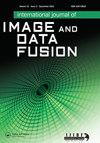图像配准的深度学习方法概述,重点介绍基于特征的方法
IF 1.8
Q3 REMOTE SENSING
International Journal of Image and Data Fusion
Pub Date : 2020-01-06
DOI:10.1080/19479832.2019.1707720
引用次数: 26
摘要
图像配准是图像重建和图像融合等计算机视觉问题的重要预处理步骤。在本文中,我们介绍了使用深度学习的图像配准方法的综述。该调查的重点是如何使用深度网络架构解决传统的图像配准方法,如基于区域和基于特征的方法。采用的配准方法取决于应用程序中图像的类型和用于描述图像之间变形的变换类型。然后,我们对卷积神经网络的性能进行了比较分析,卷积神经网络在基于特征的配准中的特征提取、匹配和转换估计方面表现良好。实验是使用通过诱导变形(如比例)生成的航空图像数据集对每种方法进行的。本文章由计算机程序翻译,如有差异,请以英文原文为准。
An overview of deep learning methods for image registration with focus on feature-based approaches
ABSTRACT Image registration is an essential pre-processing step for several computer vision problems like image reconstruction and image fusion. In this paper, we present a review on image registration approaches using deep learning. The focus of the survey presented is on how conventional image registration methods such as area-based and feature-based methods are addressed using deep net architectures. Registration approach adopted depends on type of images and type of transformation used to describe the deformation between the images in an application. We then present a comparative performance analysis of convolutional neural networks that have shown good performance across feature extraction, matching and transformation estimation in featured-based registration. Experimentation is done on each of these approaches using a dataset of aerial images generated by inducing deformations such as scale.
求助全文
通过发布文献求助,成功后即可免费获取论文全文。
去求助
来源期刊

International Journal of Image and Data Fusion
REMOTE SENSING-
CiteScore
5.00
自引率
0.00%
发文量
10
期刊介绍:
International Journal of Image and Data Fusion provides a single source of information for all aspects of image and data fusion methodologies, developments, techniques and applications. Image and data fusion techniques are important for combining the many sources of satellite, airborne and ground based imaging systems, and integrating these with other related data sets for enhanced information extraction and decision making. Image and data fusion aims at the integration of multi-sensor, multi-temporal, multi-resolution and multi-platform image data, together with geospatial data, GIS, in-situ, and other statistical data sets for improved information extraction, as well as to increase the reliability of the information. This leads to more accurate information that provides for robust operational performance, i.e. increased confidence, reduced ambiguity and improved classification enabling evidence based management. The journal welcomes original research papers, review papers, shorter letters, technical articles, book reviews and conference reports in all areas of image and data fusion including, but not limited to, the following aspects and topics: • Automatic registration/geometric aspects of fusing images with different spatial, spectral, temporal resolutions; phase information; or acquired in different modes • Pixel, feature and decision level fusion algorithms and methodologies • Data Assimilation: fusing data with models • Multi-source classification and information extraction • Integration of satellite, airborne and terrestrial sensor systems • Fusing temporal data sets for change detection studies (e.g. for Land Cover/Land Use Change studies) • Image and data mining from multi-platform, multi-source, multi-scale, multi-temporal data sets (e.g. geometric information, topological information, statistical information, etc.).
 求助内容:
求助内容: 应助结果提醒方式:
应助结果提醒方式:


